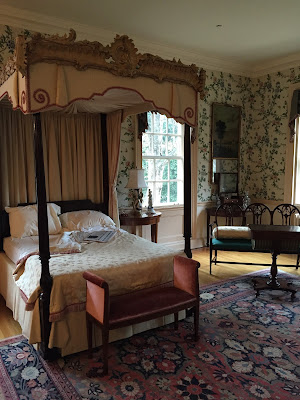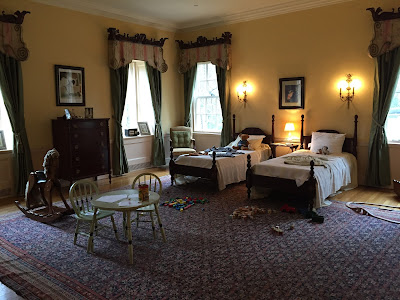I remember first falling in love with this house in the 1980s in the pages of Architectural Digest - not as a feature but the house was used as a backdrop in an ad campaign. I'm buying what they're selling!
We're all familiar with this famous facade but did you know this is actually the back?
This is the view from the street; an impressive classical Italian facade floating above formally terraced garden.
Shutze studied in Italy after wining the Rome Prize in 1915 and that shows clearly in this commission as well as in much of his other work.
The front is very different but no less impressive. A classical Palladian porte cochere welcomes one into the house. This was designed in 1928, the age of the automobile, and the house won't let you forget that early modern jazz age.
Shutze worked for the firm Hentz, Reid, & Adler and became partner while designing the Swan house for Edward and Emily Inman in 1927, afterwards known as Hentz, Adler, & Shutze.
The impressive scale of the porte cochere works despite not being classically proportioned. That's the beauty of a Beaux-Arts architectural education; once you know the rules you can break them and use them to your advantage.
Shutze also designed the formal gardens and landscaping which feature garden rooms, fountains, and enfilades similar to the Italian gardens he so loved.
This is why I'm always in favor of a classical education in whatever field you study. You can't change things without understanding a bit of the past. Don't forget Picasso and all of the great early modern artists were classically trained. These artists expanded upon an ideal -they didn't reinvent the wheel.
Most architectural schools today barely offer architectural history courses let alone a classical education. I took every architectural history course I could (unlike my fellow students) but not many were available and the offerings now are even less from what I hear. But I digress....we're not here for my views on education (or lack thereof) but for the Swan House.
Opposite the porte cochere Shutze designed a terraced garden which features perfect views of the front facade. I love these obelisks flanking the stair! As you can see it was pouring rain during our visit.
The front door has a beautiful stone quoin surround. The leaded glass transom above features a swan prominently in the design.
The front door is flanked by urn filled niches with heavy bracketed pediments above.
These urns hide small windows servicing the separate his and her 'cloak rooms' RE: powder room.
Before going inside lets take a look at the first floorplan. While a large house it's smaller than many of the awful mcmansions built today: impressive entry foyer, living room, library (functions as what we today refer to as a family room), dining room, and breakfast room. with a screened porch balancing the kitchen wing. The rest of the plan is given over to service spaces which today in modern houses are replaced by cleaning ladies and microwaves.
One enters into a small round entry vestibule. To either side are what were politely termed 'cloak rooms' (much more elegant than 'the john') and the family breakfast room.
Don't miss the amazing marble starburst floor. The HVAC vents are cleverly hidden within the pattern taking the place of the dark stone.
The floors even feature in the original blueprints! All of the broken pediment overdoors in the first floor feature vases and urns: I wonder if original from decorator Ruby Ross's scheme or has been added since being taken over by the Atlanta Historical Society in 1966.
The gentleman above in suit and hat is supposed to be the architect Philip Shutze. The house doesn't have formal guided tours but actors such as this gentleman, are available to help provide history, answer questions, and remind people to keep their hands in their pockets and not on the objects. I just would like to point out however that a gentleman such as Shutze would never have worn a hat indoors - character broken Mr. annoying actor who would NOT break character.
The stairhall is probably the most beautiful room in the house. The graceful curved stair elegantly floats in front of the view of the terraced backyard.
Everything is balanced by not symmetrical.
Above to the left is the library and to the right is the living room.
The vestibule outside of the library features a fantastically arched plaster ceiling. The small door on the left leads into a telephone closet.
The dark wood paneled library is a cozy space despite the size and looks out into the entry court. The french doors in the distance go to the screened porch.
The arched white plaster ceiling helps keep the dark room from feeling confined.
The Atlanta history museum tries to make the house museum approachable. Therefore the house is set up as if the family just left moments before. Above you see a card game in process.
Framed family portraits and other objects clutter the tabletops. The library would have been what we term the family room today remember - this is how people live, they have things.
Below is the large screened porch. I bet for a large part of the year the family really lived out here!
The living room is painted a lovely vintage green color. A number of years ago a very controversial 'restoration' occurred where a lot of the paint finishes were ruined, I mean changed, and this room is I believe one of the offenders. It's still pretty special none the less.
Again the room is set as if the family just left their morning tea on the sidetable.
The large fireplace would be lovely on a cold evening.
Below you can catch a glimpse of the living room headed up the stair.
The dining room is probably the most impressive room in the house. Featuring hand painted chinoiserie wallpaper and gorgeous furnishings, the room could have been decorated yesterday.
The ceiling detail here was designed by Shutze as was all of the architectural detailing in the house.
The table is set with one of many sets of china.
Thanks to the rainy day and my poor iphone photos you can barely catch a glimpse of one of a pair of sidetables bought at an English country house sale by the Inmans which feature swans. Legend is that it is these very tables that give the house its name (although no one knows for sure!).
I loved the details of the fireplace surround.
My favorite room in the house however, is probably the butler's pantry and kitchen.
Everything, and I mean EVERYTHING, is painted the same shade of lovely vintage green -a sort of turquoisey green.
Notice the cabinetry, walls, trim, ceiling, and even the stepstool, are painted the same shade. Love this!
A true butler's pantry, it looks out onto the entry so that staff knows when guests or family are arriving.
The cabinetry is really wonderful.
I loved the radiator above which doubles as a food warmer.
The kitchen is an extension of the butler's pantry; Everything the same shade of green and the beautiful linoleum floor continues.
The hood over the range is pretty spectacular!
Everything including the kitchen sink. Very nice to have kitchens above ground and with a lot of the same amenities found throughout the house.
Separation of church and state or rather of staff and family. Legend has it however that Mrs. Inman would not let family or staff use the main stair for fear of it looking 'worn'. Everyone democratically used the backstairs here!
Going up the main stair (we are guests afterall) notice that the windows on either side have jambs at angles to the room. Symmetry above all! This is so that the windows work just as well on the interior facade as they do on the exterior.I love these architectural paintings flanking the upper stairhall.
Second floorplan
Notice the interesting ceiling here as well. To the left is the Guest room (now furnished as a child's bedroom) and to the right is the back stair.Only 2 bedrooms on this level are open to view (such a shame!) and this was Mrs Inman's bedroom. She lived in the house until 1965.
Large but not a huge room, the fireplace still has room for a small seating area.
Her bathroom is rather oddly decorated and I'll spare you the details. I suspect it fell prey to the 'restoration'. Notice however the mirrored cabinet doors to the closets and the poured terrazzo flooring. The master bath doesn't have a tub (the family only took showers) so the only tub to be found was in the guest bath.
The guest room is set up as a child's bedroom to appeal to younger visitors who can play with the toys and draw messages to the 'family', a nice touch.
This fireplace surround is certainly too grand for a child's bedroom!
The guest bathroom remains original with beautiful fixtures and cabinetry.
Some things never go out of style, Waterworks still sells similar fixtures.
No medicine cabinet, only a glass shelf.
The staff quarters are on the top floor with the best views! This room features the round window from the rear facade. The staff shared this bathroom below but it features natural light and a bathtub so not too shabby. The old rug is a strange touch but I'm sure there is a story there.
I hope you enjoyed this brief visit to the Swan House. If you find yourself in Atlanta definitely take the time to stop by, I suspect you'll love it as much as I did!
































































0 Comments:
Post a Comment